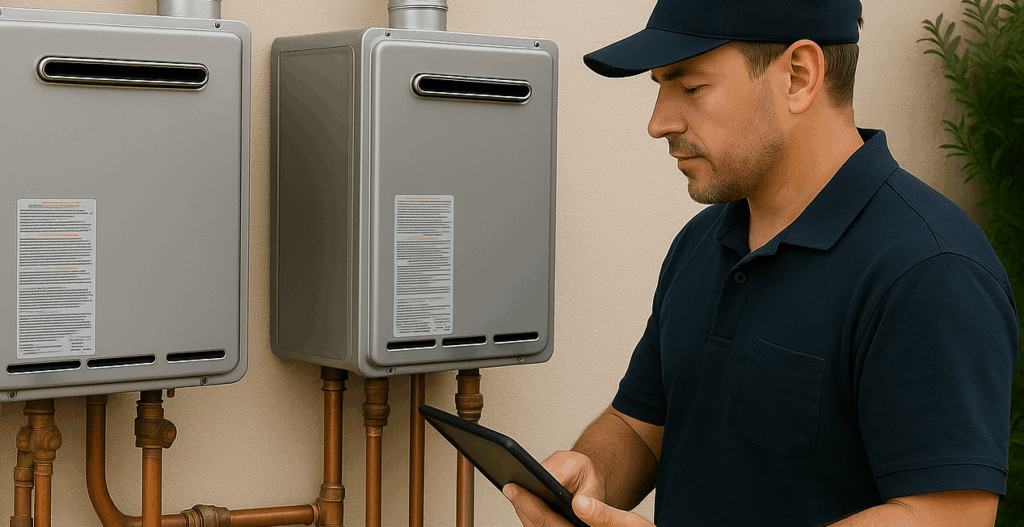A reliable supply of hot water is something most homeowners don’t think about until the day their water heater fails. Suddenly, simple routines like morning showers or washing dishes become uncomfortable or impossible. The secret to long-lasting, trouble-free hot water? Regular water heater maintenance. Whether you have a traditional tank, a tankless unit, or even a hybrid heat pump model, simple upkeep can help you avoid cold-water surprises and expensive repairs. Here are the top water heater maintenance tips every homeowner should know.
Understand Your Water Heater Type
Before you start any maintenance, know what kind of water heater you have. The most common types are storage tanks (electric or gas), tankless (on-demand), and heat pump water heaters. Each has specific care requirements and lifespan expectations. Locate your user manual, or find it online using the make and model, to understand recommended maintenance and safety precautions for your particular unit.
Check and Lower the Temperature Setting
Most water heaters are set to 140°F (60°C) by default, but for most homes, 120°F (49°C) is ideal. This temperature prevents scalding, slows mineral buildup and corrosion, and saves energy. Adjust the thermostat on your unit usually behind an access panel on electric heaters or near the gas control on gas models. Lowering the temperature can extend your heater’s life and reduce utility bills.
Flush the Tank Annually
If you have a storage tank water heater, sediment naturally accumulates at the bottom of the tank over time, especially if you have hard water. This sediment acts as insulation, making your heater work harder and less efficiently. Flushing your tank at least once a year removes this buildup. Here’s how:
- Turn off the power (or set gas to “pilot”).
- Attach a garden hose to the drain valve at the tank’s base.
- Place the other end in a floor drain or outside.
- Open the valve and let the water (and sediment) drain out until it runs clear.
- Close the valve, remove the hose, and restore power.
This simple routine can prevent noisy operation, increase efficiency, and prolong your water heater’s life.
Inspect and Replace the Anode Rod
Inside your tank water heater is an anode rod – a metal rod that attracts corrosive elements in the water, protecting the tank from rust. Over time, this rod wears out and needs replacing (usually every 3-5 years). To check it:
- Turn off the water and power to the heater.
- Unscrew the anode rod (usually on top of the tank).
- If the rod is coated with calcium, or worn down to less than half an inch thick, replace it.
A new anode rod is a small investment that can add years to your tank’s life and prevent expensive leaks.
Test the Pressure Relief Valve
The temperature and pressure relief (TPR) valve is a crucial safety device on all water heaters. It opens to relieve pressure if the tank overheats or pressure rises too high, preventing possible explosions. To test it:
- Place a bucket under the discharge pipe.
- Lift the valve’s lever to let some water out, then release it.
- If water keeps running after you release the lever, or the valve leaks, it should be replaced immediately.
Test the TPR valve once a year to ensure your water heater is operating safely.
Insulate the Tank and Pipes
Heat loss can occur as hot water sits in your tank or travels through pipes. Wrapping an older water heater with an insulating blanket (especially if it’s in a cold area) reduces standby heat loss and saves energy. Likewise, insulate the first 6 feet of both hot and cold water pipes to improve efficiency and prevent freezing.
Note: Don’t cover the thermostat or burner area on gas water heaters, and follow all safety guidelines.
Check for Leaks and Corrosion
Regularly inspect the area around your water heater for water pooling, rusty spots, or corrosion. Look for leaks at the base of the tank, around pipe joints, and near the TPR valve. Even small leaks can cause big problems over time, including mold, water damage, or electrical hazards. If you spot anything unusual, call a plumber for an inspection.
Keep the Area Around the Heater Clear
Store nothing within two feet of your water heater. This ensures proper airflow (especially for gas units), reduces fire risk, and makes inspection and maintenance easier. For gas water heaters, ensure the burner compartment is clean and free from dust or lint.
Clean the Air Intake or Exhaust Vent (for Gas and Tankless Models)
Gas water heaters and many tankless units rely on unobstructed vents for safe and efficient operation. Check the vent pipes for blockages, nests, or corrosion. If you have a tankless model, clean the air intake filter according to the manufacturer’s instructions, usually every six months. Blocked vents can cause dangerous carbon monoxide buildup and reduce efficiency.
Schedule Annual Professional Maintenance
While DIY care is essential, there’s no substitute for an expert’s eye. A licensed plumber or technician can inspect and maintain the parts you can’t easily access, flush the system more thoroughly, check the gas connections and burner, test electrical components, and make sure your unit is running safely and efficiently. Many problems are cheaper to fix when caught early.
Be Alert to Warning Signs
Unusual noises (rumbling, banging, or popping), rusty or discolored water, inconsistent water temperatures, or a sudden spike in energy bills may all indicate that your water heater needs attention. Don’t ignore these signals – early action can save you money and prevent more serious breakdowns.
Plan for Replacement Before Failure
No water heater lasts forever. Storage tank models typically last 8-12 years; tankless units can reach 15-20 with proper care. If your unit is nearing the end of its life span or requires frequent repairs, start planning for replacement now. Upgrading to a modern, energy-efficient water heater can lower your energy costs and ensure you never have to endure an unexpected cold shower.
Water heater maintenance isn’t complicated, but a little regular attention goes a long way. By following these top tips – flushing the tank, inspecting the anode rod, testing safety valves, and scheduling annual professional inspections – you can enjoy reliable hot water, lower energy bills, and peace of mind year after year. Take care of your water heater, and it will take care of you and your family for many years to come.

